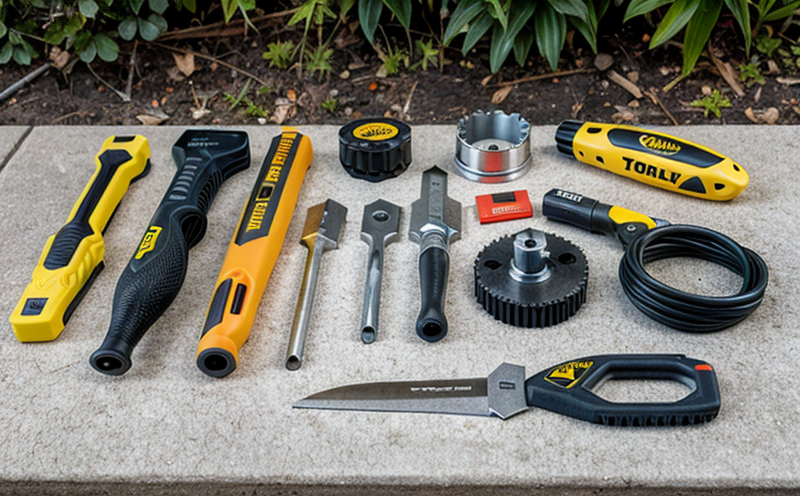Fatigue Testing of Power Tools
The fatigue testing of power tools is a critical aspect of product safety and quality assurance. This test evaluates how well a tool withstands repeated loading cycles over its expected lifetime, ensuring it does not fail prematurely under normal use conditions. Fatigue tests are essential for consumer products like DIY tools and hardware items to meet international standards while maintaining user safety.
Power tools are subject to cyclic stress during operation, which can lead to material fatigue. This phenomenon is particularly significant in high-stress areas such as gears, bearings, and fast-moving components. By conducting fatigue testing, manufacturers can identify potential weaknesses early on, allowing for design improvements that enhance durability.
The process involves subjecting the tool to a series of cyclic loads until failure occurs or until predetermined cycles are completed. The number of cycles required varies depending on factors such as material type and expected service life. For instance, power drills may undergo hundreds of thousands of cycles before showing signs of fatigue damage.
During testing, it is crucial to ensure that the specimen preparation accurately reflects real-world conditions. This includes selecting appropriate materials and ensuring they are free from defects. Once prepared, the tool must be placed in a specialized fatigue testing machine designed specifically for power tools or similar devices.
| Parameter | Description |
|---|---|
| Cycle Count | The total number of loading cycles applied to the tool. |
| Loading Rate | The rate at which the load is increased or decreased during each cycle. |
| Environmental Conditions | Temperature, humidity, and other environmental factors that can affect material properties. |
| Data Collection | Sensors used to monitor stress levels, strain rates, and any signs of impending failure. |
The data collected during fatigue testing provides valuable insights into the tool’s performance. Engineers can use this information to refine designs, optimize materials, and improve overall durability. It also helps ensure compliance with relevant international standards such as ISO 8034 for power tools.
For manufacturers aiming to enter new markets or meet specific regulatory requirements, fatigue testing is indispensable. By demonstrating a commitment to quality through rigorous testing procedures, companies can build trust and confidence among consumers and regulators alike.
Why Choose This Test
- Avoids costly recalls due to premature failures.
- Safeguards against potential injuries caused by tool malfunctions.
- Ensures compliance with international safety standards.
- Enhances brand reputation through proven reliability.
Fatigue testing is an investment in long-term product success. It helps identify areas for improvement early on, reducing the risk of costly redesigns later in the development cycle. Moreover, it plays a vital role in safeguarding end-users by preventing accidents and injuries associated with faulty tools.
By adhering to strict testing protocols, manufacturers can demonstrate their dedication to consumer safety and satisfaction. This commitment not only fosters customer trust but also opens doors for market expansion into regions where stringent quality controls are mandated.
International Acceptance and Recognition
- The International Organization for Standardization (ISO) has established guidelines for fatigue testing in various industries, including power tools under ISO 8034.
- American Society for Testing and Materials (ASTM) provides additional standards such as ASTM F1675 for specific types of drills.
- European Norms (EN) include EN 12179 which covers the general requirements for testing tools with rotating parts.
Fatigue testing is widely recognized and accepted across different regions, making it a global standard. Compliance with these standards ensures that your product meets international safety criteria and can be marketed globally without additional certification hurdles.
Many countries have their own regulatory bodies that mandate adherence to specific testing procedures. For example, the U.S. Consumer Product Safety Commission (CPSC) requires manufacturers to demonstrate compliance through rigorous testing like fatigue testing. Similarly, European Union directives impose similar requirements under Directive 2014/35/EU.
By choosing this test, you ensure your product aligns with these regulations and can be sold confidently in multiple markets worldwide.
Use Cases and Application Examples
| Tool Type | Purpose of Testing | Expected Outcomes |
|---|---|---|
| Screwdrivers | Evaluate durability in fastening applications. | Determine maximum number of screws that can be driven before failure. |
| Assess performance under varying loads and speeds. | Identify optimal settings for minimizing wear while maximizing efficiency. | |
| Impact wrenches | Test resistance to high torque impacts over extended periods. | Predict lifespan based on frequency of heavy-duty use scenarios. |
Fatigue testing is particularly useful for identifying potential weaknesses in components subjected to repetitive stress. For screwdrivers, this might involve checking the integrity of the bit socket after thousands of uses. Electric drills benefit from tests that simulate continuous drilling tasks to ensure consistent output power and reduced wear over time.





